Life
Here's Why January's Second Full Moon Is Going To Look WAY BIgger Than Usual

You might want to adjust your sleep schedule on Jan. 31 so that you don't miss the lunar phenomena that's about to occur. Why would you sacrifice precious snooze time for the same old moon? Because this isn't any ol' supermoon. If you're wondering how big the super blue blood moon will be, it certainly will be prominent enough to catch your attention. But it's rarity is what makes it worth the reduced time of your beauty sleep.
This supermoon is being called the super blue blood moon because it's not only the second time in one month that we'll be graced with a full moon — which considers it a blue moon — it's also a lunar eclipse. Which makes it a blood moon. There is a lot going on here, but I'll break it down for you Earthling style. The first detail to know? This will be the first time in 150 years we get to gawk at a super blue blood moon. While blue moons might not be as rare as we though, more on that later, blue blood moons are. The super blue blood moon's presence will grace us on Jan. 30 and Jan. 31, and the best times to snap a shot worthy of being retweeted by NASA vary depending on where you live. But no matter where you are, this moon will be so big and radiant, it'll be hard to miss.
The moon doesn't grow. But it can appear larger. When this happens the moon becomes known as a supermoon. The official NASA explanation of a supermoon is, in case you forgot your science textbooks at home and don't have Neil Degrasse Tyson on speed dial, "a full moon occurring near or at the time when the Moon is at its closest point in its orbit around Earth." This point is called the "perigee" and you'll want to remember that term to impress your friends at your next supermoon viewing party. When the full moon hits that point, it gets a boost in size according to the human eye.
According to Space.com, "the supermoon will be the day before [the lunar eclipse], on Jan. 30 at 4:58 a.m. EST." The moon will be orbiting at a mere 223,068 miles from Earth as opposed to the typical 238,855 miles. The supermoon will appear 14 percent larger than the typical moon on January 30st. The full moon eclipse occurring early in the morning on the 31st will certainly be super.
A lunar eclipse is what happens when the Sun, Earth and Moon line up perfectly which is a victory for all of us perfectionists. Sarah Noble, a Program Scientist at NASA headquarters says, "we’re seeing all of the Earth’s sunrises and sunsets at that moment reflected from the surface of the Moon." Does anyone else have goosebumps? That sounds pretty magical and well worth losing sleep over.
NASA is appropriately excited for this lunar event, saying in the same statement about the full moon, "its apparent size might make you do a double-take. You almost feel as though you could reach out, grab the glowing orb, and drop it into your coffee cup. Even more so if it’s a supermoon." Besides appearing 14 percent larger, supermoons tend to also appear 30 percent brighter. And this particular super blue blood moon will radiate a red hue thanks to all those sunrises and sunsets playing out on the screen of the moon. New Yorkers will be able to see the tinted supermoon around 5:51 a.m. on Jan. 31 according to Space.com. Those in California can catch it in all its glory around 2:51 a.m. on Jan. 31. Your Instagram will have never seemed so out of this world.